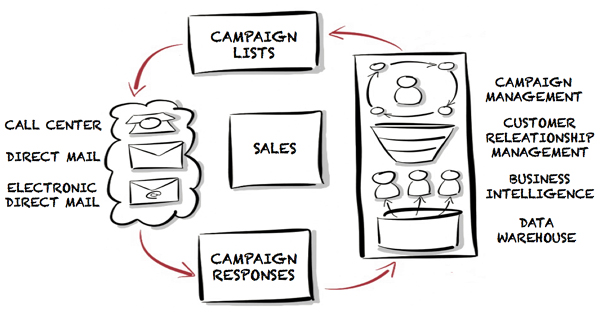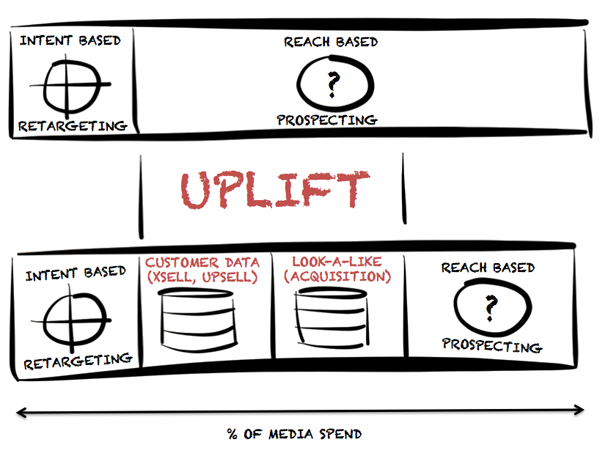
In most enterprises today, IT and marketing functions have varying but significant investments in data warehouse, business intelligence, customer relationship management and campaign management systems. All this accumulated investment in technology will be producing campaign lists for outbound call centers, direct mail and potentially electronic direct mail.
Repurposing existing campaign lists
Enterprises market to different customer segments about different products. These segments may be determined by product holdings, product usage, geo demographic or behavioural profiles.
The technology, processes and skills to create campaign lists already exist within the enterprise. Known customer segments can be matched to known product offerings and campaigns can be measured in terms of campaign responses and point of sale outcomes.
With very little additional effort, existing campaign lists can be repurposed in digital. This has two effects: first, it will provide a marked improvement over any current “spray and pray” digital media buying strategy; and second, it will provide us with a means to create a known audience and an unknown audience in digital.
The unknown audience can then be segmented based on look-a-like characteristics centred around a geo demographic or behavioural basis. Either way, the known data and look-a-like segments should produce an immediate uplift over random reach-based, prospecting approaches.
Capitalising on prior investments
The advantage to this approach is that it capitalises on prior investments in data warehousing, business intelligence, customer relationship management and campaign management as well as pre-existing teams, processes and messaging rules to engineer a quick and positive uplift result.
The trick to this approach is getting a non-personally identifiable ID that will allow you to link your campaign lists in 3rd party digital sites. This is relatively simple if you have a digital site or app that requires your customers to login in or authenticate in some fashion. For instance, they might login in to check their account balance, view and pay accounts, make transactions, post user generated content, and make comments or any other sort of authenticated activity.
Exchanging IDs by cookie syncing
When your visitors authenticate themselves, they give you a means to tie their digital activity to your data warehouse data. You can allocate them a unique but not personally identifying ID and you can then exchange this identifier with 3rd party data partners allowing you to find these same people on 3rd party sites.
The most common means of exchanging IDs is by cookie syncing. Cookie syncing essentially maps your cookie identifiers to those of another site and is used extensively in the digital ad technology ecosystem. (The process of cookie syncing is explained in more technical detail by Ad Ops Insiders if you are interested in understanding more.)
If you don’t have digital sites or apps that encourage visitor authentication (via login or social sign in), all is not lost.
You can still allocate a unique but not personally identifying ID in a cookie. You will be able to tie browsing behavior on your sites to this cookie, retarget this browser on 3rd party sites, augment what you know about this browser from 3rd party data sources and create look-a-like audiences. You just won’t be able to tie this browser to data or campaign segmentation from your data warehouse without some form of authentication.
5 steps to data driven advertising
The next steps are relatively straightforward but are each worthy of blog posts on their own:
1. Transfer your existing campaign lists on a monthly, weekly or nightly basis to a data management platform (DMP) using your non-personally identifiable identifier as the key
2. Set up programmatic buying such as bids on demand side platforms to buy against these campaign lists
3. Expose these same campaign lists to your digital sites and apps to allow testing and optimisation to operate on your data warehouse data and 3rd party data obtained from partners.
4. Augment your audience segments with real-time analytics and augment your analytics with data from your data management platform, bringing your data warehouse data and 3rd party data into your analytics reports.
5. Use data from your data warehouse, analytics, data management platform and programmatic buying to develop weighted attribution models that provide optimal media mixes for combinations of products and campaign segmentations.
The important thing is to get started. You very likely have a lot of infrastructure and processes already in place and with a relatively small amount of effort and investment you can get started in data driven marketing.
Use small trials with pre-existing and high performing segments to get hard numbers to present to key stakeholders. Use these early successes to drive further investment and before you know it, you will have transformed your existing digital marketing spend from a broadcast-based prospecting model to targeted media buys generating uplift in performance.
About Steve Poyser



